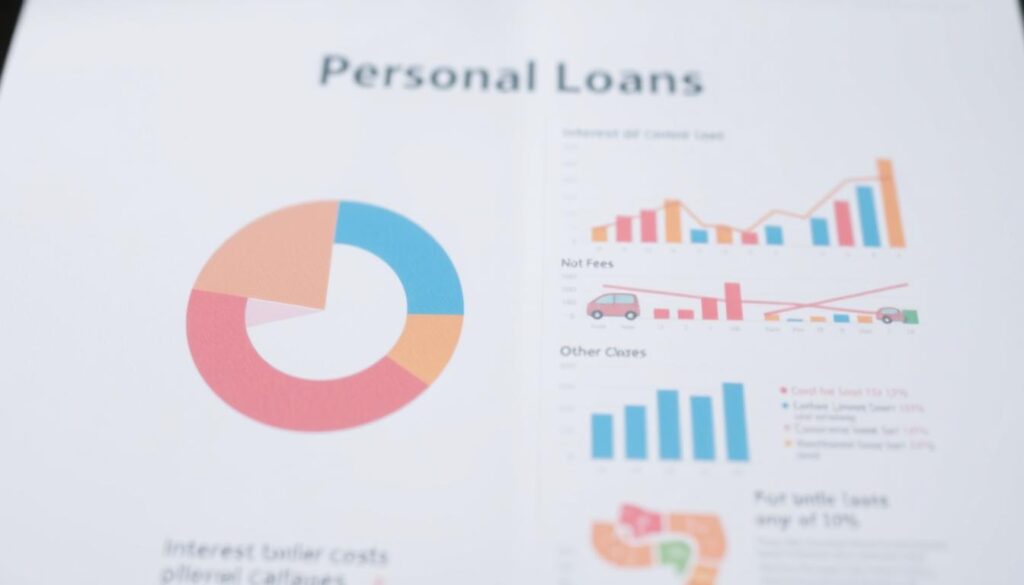When you get a personal loan, it’s important to know the real cost. Hidden fees can add up fast. It’s key to have clear information to avoid surprises.
Nearly 50% of lenders charge origination fees. These can be from 1% to 8% of the loan. Always check the fees before you sign anything.
Origination fees can change the loan’s total cost a lot. About 60% of lenders charge late fees for missed payments. These fees can be $10 to $39 or 5% of the late amount.
Knowing about personal loan fees is crucial. By understanding origination, late, and other fees, you can avoid extra costs. This knowledge helps you make a smart choice when borrowing money.
Understanding the True Cost of Personal Loans
When you think about getting a personal loan, it’s key to know the real cost. This isn’t just the interest rate. It also includes extra charges like origination fees, late fees, and penalties for paying off early. Knowing these costs helps you make a smart choice and avoid surprises.
Lenders add extra fees to cover their costs of handling the loan. These fees can differ a lot, with origination fees ranging from 1% to 6% of the loan amount. It’s important to look at the loan fee disclosure and figure out the total you’ll owe.

Some lenders, like the Economic Justice Fund, don’t charge any fees. Others might have application fees, servicing fees, and penalties for early payment. To avoid getting stuck with high-interest debt, it’s crucial to understand loans well. Online loan calculators can help you see the total you’ll pay, including principal, interest, and extra fees.
Common Fee Structures
Here are some common fees for personal loans:
- Origination fees: 1% to 6% of the loan amount
- Late fees: charged when a payment is missed or late
- Prepayment penalties: charged when a loan is paid off early
Why Lenders Charge Additional Fees
Lenders add extra fees to cover their costs of processing and servicing the loan. These fees can vary a lot. It’s important to review the loan fee disclosure to understand the total cost of borrowing.
Hidden Fees in Personal Loans That Could Surprise You
When you get a personal loan, it’s key to know about hidden fees. Avoiding hidden charges means reading the fine print well. Some lenders might charge annual fees, late fees, or penalties for paying off early. These can add up fast.
Be on the lookout for fees like processing, documentation, and late payment fees. These can be 1% to 3% of the loan amount. Uncovering loan costs means checking the agreement and asking about unclear fees. This way, you can avoid surprises.
Here are some hidden fees to watch out for:
- Processing fees: 1% to 3% of the loan amount
- Late payment fees: up to 1-2% of the EMI amount
- Prepayment penalties: 2-5% of the outstanding loan amount
Comparing personal loan offers from different lenders helps you spot hidden fees. This way, you can pick the best one for you.

Knowing about these hidden fees can save you money. Always read the fine print and ask about unclear fees. With some research, you can understand your loan’s true costs and make a smart choice.
| Fee Type | Fee Range |
|---|---|
| Processing Fee | 1% to 3% of the loan amount |
| Late Payment Fee | up to 1-2% of the EMI amount |
| Prepayment Penalty | 2-5% of the outstanding loan amount |
Application and Origination Charges Explained
When you think about getting a personal loan, it’s key to know about the different fees. This includes application and origination fees. These fees can really change how much you’ll pay back, so it’s important to look at them closely. Origination fees can be between 1% and 10% of the loan amount. Some lenders might even charge up to 12% for those with bad credit.
It’s important to understand how these fees work. For example, a $10,000 loan with a 5% origination fee means you’ll get $9,500. You should think about these fees when figuring out the loan’s total cost. Some lenders let you add the fee to the loan or take it out of the money you get.
Processing Fee Breakdown
Origination fees can change a lot based on the lender and your credit score. Personal loan rates are often over 12%. People with credit scores above 670 usually get better rates. Let’s say you need a $20,000 loan with a 5% origination fee. You would need to ask for $21,053 to get the full $20,000.
Documentation Charges and Third-party Service Fees
Besides origination fees, there are other costs like documentation fees and third-party service fees. These can add up fast. It’s crucial to read the loan terms well to understand all the fees. By focusing on transparency in lending and looking at the loan cost breakdown carefully, you can make smart choices and avoid surprises.
Penalty Fees You Might Not Expect
When you get a personal loan, it’s key to know about the personal loan fees involved. There are more than just interest rates and origination fees. Lenders might also charge additional charges in loans that can quickly add up. Penalty fees, in particular, can be a big problem if you don’t see them coming.
Some common penalty fees include late fees, prepayment penalties, and NSF fees. For instance, late fees can be between $29 to $39, depending on the lender. To dodge these fees, it’s important to pay on time and know your loan’s terms.
To lessen the effect of personal loan fees and additional charges in loans, here are some tips:
- Read the fine print: Carefully review your loan agreement to understand all the fees associated with your loan.
- Make timely payments: Set up automatic payments to ensure you never miss a payment.
- Choose a lender with no penalty fees: Some lenders, like Happy Money, SoFi, and LightStream, do not charge late fees.
By knowing about these penalty fees and taking steps to avoiding hidden charges, you can make a smart choice. Always check the terms of your loan agreement and ask questions if you’re unsure about any fees.
Understanding Annual Percentage Rate vs. Interest Rate
When you borrow money, knowing the difference between APR and interest rate is key. The APR includes the interest rate and extra fees like lender fees. This gives you a full view of the loan’s total cost. On the other hand, the interest rate just shows the cost of borrowing.
A loan cost breakdown helps you see the real cost of borrowing. For example, a $18,000 loan with a 12.99% interest rate and no fees has an APR of 12.99%. But, if there’s a 5% origination fee, the APR jumps to 15.18%. This shows why transparency in lending and loan fee disclosure are important to avoid hidden costs.
Here are some key things to think about when looking at APR and interest rates:
- Fixed vs. variable interest rates
- Origination fees and other borrowing costs
- Creditworthiness and its impact on interest rates
Understanding APR and interest rates helps you make smart choices and avoid surprises. Always check the loan cost breakdown and look for transparency in lending. This way, you can get the best deal.
| Loan Amount | Interest Rate | APR | Total Cost |
|---|---|---|---|
| $18,000 | 12.99% | 12.99% | $6,567.79 |
| $18,000 | 12.99% | 15.18% | $7,467.79 |
How to Spot and Avoid Predatory Lending Practices
Predatory lenders often add unnecessary “junk fees” which can significantly increase the total cost of the loan. To avoid these charges, it’s essential to carefully review the
When uncovering loan costs, consider the following:
- Check the interest rate and APR to ensure they are reasonable
- Look for any prepayment penalties or fees
- Verify that the lender reports on-time payments to major credit bureaus
By being aware of these factors and taking the time to review the loan terms, you can avoid predatory lending practices and make an informed decision. Remember to always prioritize avoiding hidden charges and carefully evaluate the loan fine print to ensure you’re getting a fair deal.
| Lender Type | Interest Rate | Fees |
|---|---|---|
| Legitimate Lender | 6-12% | None or low |
| Predatory Lender | 100%+ | High |
Smart Borrowing: Protecting Yourself from Unnecessary Charges
Being a smart borrower is key to avoiding extra charges on personal loans. By understanding transparency in lending, you can see the real loan cost breakdown. This helps you avoid hidden loan fees.
Reading the fine print and comparing lenders is crucial. Asking questions can also help you make a smart choice. This way, you won’t pay more than you expected.
Personal loan interest rates vary a lot. They can be as low as 6% for those with great credit or as high as 36% for those with poor credit. Payday loans are even worse, with APRs up to 500%.
Looking into other options like home equity loans or 401(k) loans can help. These might offer lower costs.
Being a smart borrower means knowing the full cost of your loan. This includes any hidden fees. By being careful and informed, you can avoid extra charges. This ensures you get the best deal on your personal loan.

